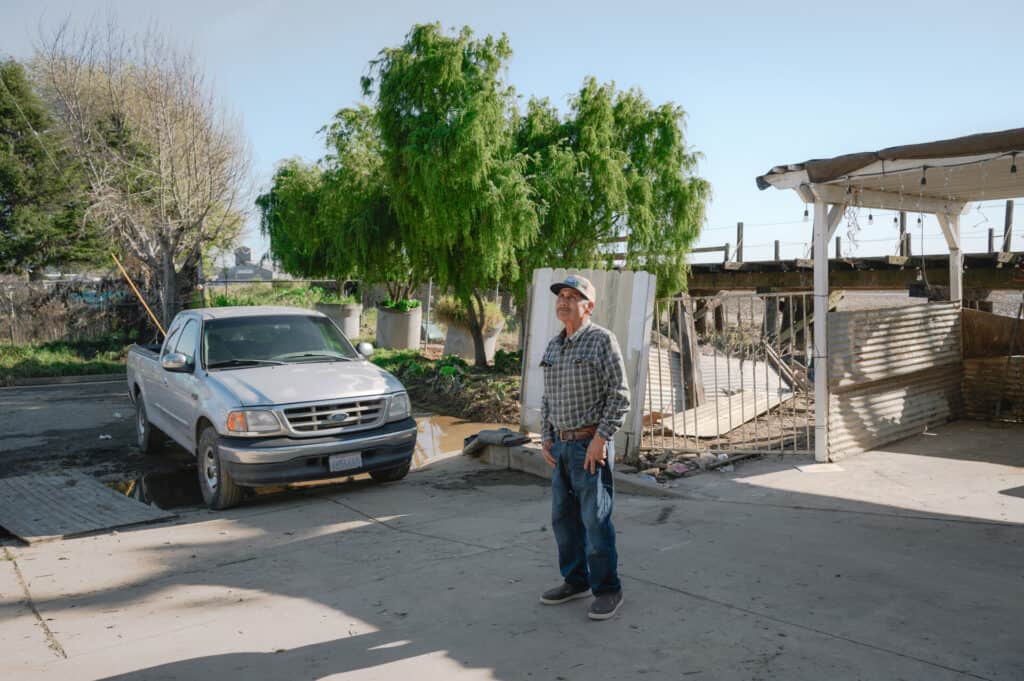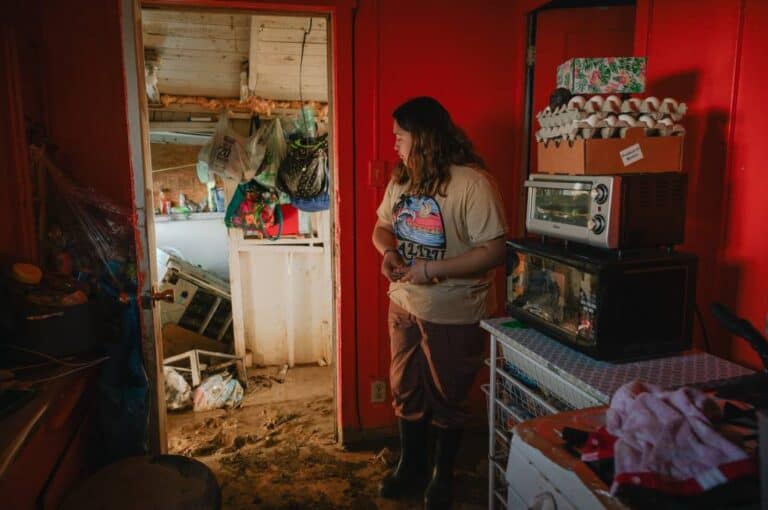Photo: Climate activist and Pajaro Valley High School senior Denia Escutia,18, stands in the family’s mud-coated kitchen in Pajaro on March 24, 2023, just days after residents began returning to their homes. Several weeks ago, Pajaro residents were forced to evacuate before dawn after an upstream levee breached, spurring widespread flooding. (Kori Suzuki/KQED)
The street in front of Antonio Hueso’s two-story, yellow-daisy-colored home in Pajaro turned into a 5-foot-deep muddy river in the early morning hours of March 12, submerging his baby-blue Ford F-150 truck and flooding his first floor.
‘As disruptive as this year’s events have been, we’re nowhere near to a plausible worst-case storm and flood scenario for California.’
—Daniel Swain, UCLA climate scientist
“In Pajaro, nothing is going to change, because poor people live here,” said Hueso, 72, a retired farmworker, recounting more than three decades of requests from the community for local, state and federal officials to fix the aging levee on the Pajaro River, 4 miles upstream of his town.
Several weeks after the levee failed — once again — forcing thousands of Pajaro residents to flee in the predawn darkness as water rushed toward their lower-income community in northern Monterey County, Hueso is beginning the arduous task of renovating his flood-damaged home. Over the nearly five decades he’s lived here, this is now the second time he has had to do this — having already lived through an equally devastating flood in 1995.

Officials say a major levee update could begin as soon as 2025, but Hueso questions whether those plans will account for the changing climate and the increased frequency and ferocity of storms expected.
He is now considering leaving.
“I’m going to fix my house, and when people forget about the flooding, I will sell my house and move to Madera or Fresno,” he said.
‘Nowhere near’ a worst-case scenario
Climate scientists warn that what Californians have lived through in recent months is just a preview of what’s to come, with exponentially worse flooding predicted in future years.
“As disruptive as this year’s events have been, we’re nowhere near to a plausible worst-case storm and flood scenario for California,” said UCLA climate scientist Daniel Swain.
“We’re not necessarily talking about 100 years from now. We’re talking about the next 20 or 30 years,”
—Daniel Swain, UCLA climate scientist
Before cities and farmland dominated the terrain, much of California was perpetually wet, with a vast system of rivers and waterways running through its core. Catastrophic floods reshaped the landscape every few centuries.
Swain is unequivocal about the links between a warming climate due to the burning of fossil fuels and the significant increase in extreme flooding. A 2022 study Swain co-authored found that the warming climate has already doubled the probability of a megaflood caused by a string of extreme atmospheric rivers.
Before cities and farmland dominated the terrain, much of California was perpetually wet, with a vast system of rivers and waterways…
Every degree of new warming increases that likelihood even more, he said.
In other words, what was once considered unlikely to happen in our lifetimes “has become quite likely,” Swain said, adding that he wouldn’t be surprised if as many as four megafloods happened just in this century.
“We’re not necessarily talking about 100 years from now. We’re talking about the next 20 or 30 years,” he said. “We’ve gotten a taste of widespread flooding, but I do think it’s only a taste.”
California has already been hit by more than 30 atmospheric rivers since October. But in order to be categorized as an extreme scenario, those weather events would have had to take place in rapid succession, with little or no time in between.
This year, by contrast, there were breaks of up to a month between each of the storms. And despite the havoc they wreaked, none were technically considered “extreme,” Swain said.
“This winter, we’ve gotten lucky, believe it or not, because things could have been significantly worse than they were,” he said. “It is possible to have years where there are multiple atmospheric rivers in a row that are much stronger than what we saw at any point this year.”
Swain said the recent storms dropped only about half the precipitation and less than a quarter of the runoff than in the “plausible worst-case scenario” he describes in his study. The resulting “megaflood” conditions, he said, would cause […]
Full article: This Winter’s Floods May Be ‘Only a Taste’ of the Megafloods to Come, Climate Scientists Warn

